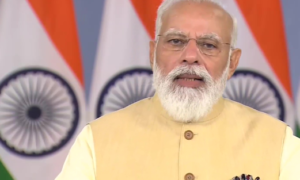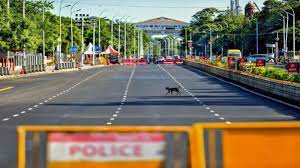A three part article, on the HR & CE Department of the Govt. Tamilnadu. First Part gives an insight on the formation of HR &CE & how Govt acquired control of temples.

It is a great irony that a secular Government should deeply embroil itself in the administration and running of Hindu temples and institutions in the guise of supervising the secular aspects of temple administration. This grotesque policy of the Government to supervise religious institutions applies only to Hindu Religious institutions.
Vise like grip on Religious Institutions
By its own account the HR & CE Dept administers (or rather mal-administers):
- 36,425 temples
- 56 Mutts
- 47 temples belonging to Mutts
- 1721 Specific endowments and 189 Trusts
This has been possible due to Tamil Nadu being ruled continuously by atheists and unscrupulous persons, a corrupt bureaucracy, a debased High Court and above all, stark apathy, indifference and ignorance among Hindus. In recent times, the covert and overt designs of Christian missionaries and agencies have added to the plight of Hindu temples.
Around 1840, the then British Government started giving up administration of temples. They asked some of the prominent mutts in Tamil Nadu to look after some of the important temples and endowments. The Heads of Mutts who were happy to take over the administration of these temples so that they are run as they ought to be run, were careful enough to get written documents or “Muchalikas” from the British Government, which assured them that they would not take back the temples from the Mutts.
Thus some very important temples came under the complete control and ownership of these Mutts and the Mutts ran them ably and efficiently. The primary purposes of worship and utilization of funds meant for the upkeep of temples and conduct of rituals were never lost sight of by the Heads of Mutts or officers. While a few temples were thus brilliantly administered by the Mutts, thousands of other temples in the then Madras Presidency were handed over to the respective trustees with the then Government playing little or no role in supervising them.
In 1925, the Madras Hindu Religious Endowments Act, 1923 (Act I of 1925) was passed by the local Legislature with the object of providing for better governance and administration of certain religious endowments. The Act divided temples into what are known as Excepted and Non-excepted temples. Immediately after the Act came into force, its validity was challenged on the ground that the Act was not validly passed. For this reason, the legislature enacted the Madras Hindu Religious Endowments Act, 1926, Act II of 1927 repealing Act I of 1925.
This Act was amended from time to time. It is unnecessary to refer to the changes introduced later. Suffice it to say that the Act was amended by 1946 by as many as ten Acts I of 1928, V of 1929, IV of 1930, XI of 1931, XI of 1934, XII Of 1935, XX of 1938, XXII of 1939, V of 1944 and X of 1946. A radical change was introduced, however, by Act XII of 1935. The Government was not satisfied with the powers of the Board then existing and they clothed the Board with an important and drastic power by introducing a new Chapter, Ch. VI-A, by which jurisdiction was given to the Board to notify a temple for reasons to be given by it.
Thus, it can be seen that even in the pre-independence era, the Board had systematically consolidated its powers to take over and administer temples. Of course, this despicable intervention by Government applied only to Hindu Institutions.
Hindu Religious Endowments Board
Shri Krupananda Vaariar had undertaken to build the Vadalur Ramalinga Swami’s Sathya Gnana Sabha in the 1940s and had gone around Tamil Nadu collecting funds from devotees and spending such collection with great care. The Hindu Religious Board, of which one Chinnaiah Pillai was president, intervened in the selfless work of Shri Vaariar and tried his best to scuttle it. Thanks to the just intervention of the then Chief Minister of Madras State, Omandur Ramaswamy Reddiar, his evil designs fell flat.
Omandur Reddiar also intervened to stop the unjust takeover of Chidambaram Sabhanayagar Temple in 1947. But Chinnaiah Pillai and his cronies in the HRE Board were not to give up.
The 1951 Act
Notwithstanding the clear directions of the Madras Government in 1947 to drop notification proceedings and the clear direction of the Hon’ble Madras High Court in 1939 that the Board cannot undertake notification process on frivolous grounds, the Board started the notification process of the Chidambaram Shri Sabhanayagar Temple in 1950 and the then Madras Government issued a Government Order (G.O.) Ms. 894, Rural Welfare Dept. dated 28-8-1951 published in the Fort St. George Gazette on 4-9-1951.
Meanwhile, India after gaining independence from British rule had become a Republic on 26 January 1950, with its Constitution guaranteeing certain fundamental rights to its citizens. Special religious and administrative rights were guaranteed to Religious Denominations or sections thereof.
The Board also tried to take over the famous Shri Guruvayurappan Temple in Guruvayur, Udupi Shri Krishna Temple under the management of Shri Shirur Mutt of Udupi and Shri Venkataramana Temple belonging to the sect of Gowd Saraswath Brahmins in Mulkipetta of South Kanara district.
All the above religious institutions challenged the takeover by the HRE Board. In the meantime, a new Hindu Religious Act was passed by the Madras Government, known as the Hindu Religious and Charitable Endowments Act, 1951. The Board was now replaced by the Hindu Religious & Charitable Endowments Department, headed by a Commissioner who was given vast powers under the Act.
The Government facing stiff opposition in the Kerala region against its order on Guruvayur temple, withdrew the order. Shri Lakshmindra Thirtha Swamiar of the Shirur Mutt, the Podu Dikshitars of Shri Sabhanayagar Temple and Devaraja Shenoy representing the community of Gowd Saraswat Brahmins in Mulkipetta filed Civil Miscellaneous and Writ petitions challenging the Government Orders.
Landmark Judgments
On 13 December 1951, a Division Bench of Hon’ble Madras High Court presided by the Learned Judges Justice Satyanarayana Rao and Justice Rajagopalan passed two landmark judgments.
1952 I MLJ 481 – Devaraja Shenoy vs. State of Madras – quashing the Government order to takeover the administration of the Shri Venkataramana Temple in Mulkipetta.
1952 I MLJ 557 – Shri Lakshmindra Thirtha Swamiar of Shri Shirur Mutt vs. State of Madras quashing the Government order to takeover the administration of Shri Udupi Krishna Temple and Shri Sabhanayagar Temple in Chidambaram.
In the Shirur Mutt Case, many provisions of the new HR & CE Act of 1951 were held ultra vires of the Constitution. The Division Bench clearly defined a Religious Denomination, their rights – religious and administrative. It also explained how these rights were intermingled and could not be separated in the case of a Mathathipathi and since it was the same with the Podu Dikshitars of Chidambaram Temple, it equated them to Mathathipathis.
Equally important were the findings of the Division Bench that the attempt of the Board and the Commissioner HR & CE to takeover the temples were not only unconstitutional but bad on merits.
Appeals to Supreme Court
The Government of Madras filed three appeals against these two landmark verdicts. On 9 February 1954, a five-judge Constitution Bench of the Hon’ble Supreme Court dismissed the civil appeal 39/1953 after recording the statement of the Advocate General of the Madras Government that the G.O. passed to take over the Chidambaram Shri Sabhanayagar Temple would be withdrawn. The Government sought no leave and none was granted.
Similarly the Government’s Civil Appeal no.15/1953 filed against the verdict of Hon’ble Madras Court in the Shri Venkataramana Temple Mulkipetta was also dismissed after the Government offered to withdraw the G.O. appointing the Executive Officer.
The Government of Madras contested only the Civil Appeal 38 of 1953, pertaining to the Shirur Mutt Case and even in that appeal did not contest on merits. The Advocate General argued only on constitutional grounds. This was clearly recorded in the Supreme Court judgment.
Thus, it is amply clear that the HR & CE Department and the Government never had any case right from the beginning on merits, and they simply wanted to takeover the administration of large and famous temples to pave way for the takeover of all other temples in the Presidency.
The 1954 Supreme Court judgment in the Shirur Mutt Case
The judgment of the Constitution Bench of the Supreme Court in the appeal related to the Shirur Mutt (AIR 1954 SC 282) and the judgment by another Constitution Bench in the Venkataramana Devaru vs. State of Mysore (1958 SCR 895) are landmark judgments that Courts in India are expected to follow regarding Article 26 of the Indian Constitution and Denomination rights.
The Hon’ble Supreme Court agreed with the Hon’ble Madras High Court that many of the sections of the 1951 HR & CE Act were ultra vires the Constitution. It also clearly observed that while the legislature could seek to regulate the administration, it must always leave the administration to the denomination. It struck down the sections of the 1951 Act which sought to appoint Executive Officers to religious institutions as arbitrary and ultra vires the Constitution. The Advocate General of Madras agreed with the Court and said he could not defend those sections.
Major Fraud by the Madras Government in the 1959 Act
Left with no choice but to come up with an amended Act in light of the above judgments of the Madras High Court and Supreme Court of India, the Government of Madras passed a new Act known as the Hindu Religious & Charitable Endowments Act of 1959 (Act 22 of 1959).
In that amended Act, it committed serious frauds which till today continue unchallenged. To understand these frauds we need to know more about the 1954 Supreme Court judgment in the Shirur Mutt Case.
Under the 1951 Act, the HR & CE Dept. had powers under sections 56, 58(3)(b) and 63 to 68 to appoint an Executive Officer to religious institutions including Mutts. Of these, sections 56 and 63-68 were held ultra vires the Constitution of India and were struck down by the Hon’ble Supreme Court in the above-mentioned judgment. The same judgment upheld Sec. 58(3)(b) as valid (this section was earlier struck down by the Division Bench of Madras High Court) since there were adequate appeal safeguards and since the Executive Officer so appointed could only be a servant of the Trustee and could not be empowered to act as the Trustee himself.
Any honest and law-abiding person would imagine that the Madras Government, in deference to the Supreme Court of India and to meet the ends of justice, would have deleted the two sets of sections struck down and retained the section upheld by the Hon’ble Supreme Court.
What happened was exactly the opposite.
The Government of Madras introduced a new section [section 45] in the 1959 Act which was even more arbitrary and draconian than Sec. 56 of the 1951 Act. It also retained the Sections 63-68 in the new Act which now carried the numbers 71-76.
The only section relating to appointment of Executive Officer that was upheld by the Hon’ble Supreme Court was not carried in the new Act. But this would not seem strange if we understand that the intention of the Government and the Department was that no appeal safeguards should be provided to the Trustees of Hindu Institutions against the Department’s illegal and arbitrary orders. Sec. 58(3)(b) of the 1951 Act had earlier afforded such safeguards – it was therefore removed by the Government.
More intriguing is the fact that this rogue department continue to appoint Executive Officers under Sec. 64 of the 1959 Act (the equivalent of Sec. 58 in the 1951 Act) without any power to do so. For example, the Deputy Commissioner in 1963 modified the scheme for Shri Kamakshi Amman Temple of Kachipuram, which is under the ownership of the Kanchi Mutt. While proceeding to modify the scheme under Sec. 64 of the Act, the Deputy Commissioner appointed an Executive Officer and this is an illegal act.
These frauds show there were adequate number of scoundrels and scalawags in the HR & CE Department sixty years ago, and we all know the Dept. has no dearth of such people now.
Going against the dictum of the Hon’ble High Court and the Hon’ble Supreme Court did not stop here. One classic example of the arrogance of the Government is the amendment they brought out soon after the Full Bench judgment in the Rajan Kattalai Case in the Supreme Court (1965 SCR (3) 17). In this case, to get over the quashing of the Extension of the Executive Officer’s appointment, the Government amended the HR & CE Act introducing Sec. 75-A which gave such extensions retrospective effect notwithstanding any judgments by any courts including the Supreme Court. This attempt to retain control over Rajan Kattalai of Tiruvarur Thiagarajaswami Devasthanam in utter contempt to the judgment of the Highest Court of the land in that case was thwarted by the Hon’ble Madras High Court. The Hon’ble High Court of Madras, held:
“by introducing Section 75-A the Legislature has simply directed the Commissioner of Hindu Religious and Charitable Endowments and Executive Officer of Sri Thiagarajaswami Temple to disobey or disregard the decision of the highest court of the land in S.D.G. Pandara Sannadhi v. State of Madras (1965) 2 M.L.J. 167. The obvious purpose of Section 75-A extending the impugned notification is to nullify the effect of this decision of the Supreme Court.”
(emphasis added).
In view of this judgment of the Madras High Court, the Government could not succeed in retaining administration of Rajan Kattalai Endowment, but this and other illegal sections 75-B and 75-C are still part of the HR & CE Act, not only in utter disregard of the dictum of the Supreme Court of India, but also in violation of Article 31A(1)(b) of the Constitution.
To be continued…..
Shri.T.R.Ramesh is a banking professional and research scholar on Hindu religious affairs, and has pioneered the movement against Government control over temples, protection of temple assets, for almost 2 decades. He has filed number of cases against Governments against temple asset mismanagement, fighting for the rights of devotees.
President - Temple Worshippers Society.
President - Indic Collective Trust
This article in full was first published in Vijayavaani.com during 2011.



























 WhatsApp us
WhatsApp us
Pingback: birch benders keto pancake mix
Pingback: the best gay dating site
Pingback: buy 10 clomid pills
Pingback: aralen 300
Pingback: baricitinib tablets
Pingback: cost tizanidine
Pingback: olumiant fda
Pingback: aralen brand
Pingback: buy magic boom bars online
Pingback: situs togel pasti bayar